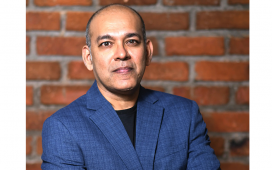18 12 for ’18 (the old rules no longer apply)
Elie Khouri is the CEO of Omnicom Media Group MENA
 So, did I catch you off-guard? Every year, I share my predictions with Campaign using the year as a marker for the number of upcoming themes. Given the period of unprecedented disturbance we’ve been facing, I thought it was time to revisit things. Looking back at last year’s list, there was one prediction I vastly underestimated and that was the severity of cuts in advertising investments in the region. I projected a 10 per cent drop in 2017, and it will end up closer to 20 per cent. So, this year, I’ll only make 12 predictions for two reasons; first, because that’s all we can afford, and second, you’ll have less content to contend with!
So, did I catch you off-guard? Every year, I share my predictions with Campaign using the year as a marker for the number of upcoming themes. Given the period of unprecedented disturbance we’ve been facing, I thought it was time to revisit things. Looking back at last year’s list, there was one prediction I vastly underestimated and that was the severity of cuts in advertising investments in the region. I projected a 10 per cent drop in 2017, and it will end up closer to 20 per cent. So, this year, I’ll only make 12 predictions for two reasons; first, because that’s all we can afford, and second, you’ll have less content to contend with!
Joking aside, there is more to this than disruption or cyclical trends. It’s been a double-whammy of both at the same time. The first blow comes from the ongoing wars in the region, the low oil prices, new taxation and the reduction of subsidies across the GCC. There is also the impact of Saudisation, with the kingdom losing some 2 million people in the last two years, and the 50 per cent currency devaluation in Egypt. This led to either a stagnation or a drop in sales, and some clients overreacted with severe and, in some cases, unjustified budget cuts. Consequently, the MENA market has shed some 35 per cent of total media investments since 2015. We’ve gone from $5.5 billion to a projected $3.6 billion by the end of 2017.
The second trend is more transformative, caused by changing consumer habits and advancements in technology. First, the Facebook/Google duo continues to dominate the market and put publishers under added strain, resulting in layoffs and an ongoing struggle to pivot. Secondly, consultancies are encroaching on our business so we must transform quickly and purposefully, adding greater value to our clients with our strategic thinking. Thirdly, as we access more useful data and consumers become increasingly attention-poor, we need to revisit traditional planning approaches. Moving from targeting masses to targeting individuals at scale, it’s less about just media performance and more about delivering long-term business value.
For 2018, I want to reset the dial and move away from the clichéd buzzwords that have dominated the last few years (AI, AR, VR, IoT) and focus instead on what will affect us here in MENA.
1.We will bottom out
Naysayers may actually be proved wrong and in 2018 we should see investments stabilise, rather than drop further. While some advertisers may offset the introduction of VAT with a 5 per cent cut in advertising budgets, the majority have realised the risks or even damage that restricted budgets can create in terms of brand performance. Economic activity indicators, like the purchasing managers indexes (PMIs), are following a positive trend. The hugely significant Saudi market shows very promising signs, including an expansionary budget for 2018 and bigger public-sector marketing investments. The lifting of the driving ban for women next June will not only see females becoming more mobile but, together with plans to facilitate their economic participation, will also lead to a boost in consumption. The Saudi and Egyptian presence in the FIFA World Cup in Russia will certainly increase advertising investments as well.
2. The Saudi powerhouse will restart
There is a renewed energy in the kingdom, with the impetus for change and transformation firmly set in people’s minds, particularly among the youth. The momentum from Vision 2030 is affecting many aspects of society (for example, improving the nation’s health through exercise) and sectors of the economy (such as the creation of the NEOM megacity). Coupled with the promise of increased government spending in 2018, the mood in the kingdom is turning positive. As the market opens up to international investors and its industrial fabric is remodelled, the opportunity to capitalise on this shift, by having and nurturing the best talent in this crucial market, is stronger than ever.
3. Egypt’s gift to the GCC
Egypt has been struggling for the past few years and its currency devaluation in late 2016 has compounded these problems. The recent indirect nationalisation of media outlets, the closure of research companies and the banning of hundreds of sites don’t bode well for press or business freedom. This is clearly a concern for the incredible tech and media talent in the country, who are now looking at emigration as a serious option. The GCC countries stand to gain from this brain-drain, as they pin their future on technology and communications.
4. Marketers will double their data management investments
If in the past the problem was finding enough reliable data to work with, today it’s knowing what to do with all the data we’ve got. Most marketers are now paying attention to the fact that they’re sitting on a gold mine with the data they glean from their consumers. In order to make full use of it, they will substantially increase their investments in data management, both from a technological and a human standpoint.
5. Digital will overtake TV investments
A decade ago, we may have lamented the fact that digital advertising investments barely reached 1 per cent of total media budgets, but today, at 35 per cent they stand to overtake those on TV. This is the result of cuts in TV advertising budgets and an increase in digital investments. Marketers are also moving budgets lower down the purchase funnel. While the shift represents a major change for older companies, it’s a given for digital natives who have bypassed TV to go straight to Facebook, Google and programmatic. These three are the main drivers of a move towards data-driven marketing and refined targeting.
6. Cruising speed for programmatic
Hitting the bullseye every time has long been the ambition of marketers around the world, making wastage a thing of the past, and programmatic advertising has proven very effective in this. It’s no wonder, therefore, that we’ve seen such demand. But in the rush to implement, some aspects have received little attention. Fraud, brand safety and viewability have recently been highlighted as areas of concern and are now being addressed. In 2018, we’ll see the attention turning even more to transparency and quality. While the focus on effectiveness remains, it will be balanced with a careful selection of suitable environments that contribute to brand-building. While growth rates will slow down to reflect this shift, the benefits of targeting and personalising at scale will continue to make programmatic advertising an essential component of marketers’ plans.
7. The proof is in the viewing
The budgets gained by digital media first came at the expense of print, but now are increasingly coming from TV, a medium whose dominant position seemed unassailable. One of the key issues with TV has long been its measurability. When times were good, there was little incentive for TV operators to open the door to precision and accountability. Now that tough times are here, the introduction of people meters may provide the necessary impetus for ad investments in Saudi Arabia and therefore gain traction. There is still some work to be done, but failure to embrace the initiative will prove to be a costly mistake. Without a fully functioning measurement system, the future of TV investments is bleak, so the whole industry needs to actively engage with the Saudi Media Measurement Company and get involved in both a support and a supervisory capacity.
8. The duopoly will become more accountable
In response to increasing cries from clients and agencies that Google and Facebook (and you can add Snapchat) simply can’t keep marking their own homework, the tech giants will dial up the transparency next year. While most advertisers were happy to continue using these platforms, as long as they delivered results, poor viewability figures and overestimated data have shaken their confidence. The digital giants will open up to more Media Rating Council-endorsed measurement partners, a necessary step towards restoring confidence after recent controversies. This alone won’t be enough, though; they will need to report back and communicate effectively with clients and agencies on results and developments.
9. Video is everywhere
Our mobile lifestyle has made video a dominant form of communication. In 2018, 73 per cent of the region’s total IP traffic will be for that type of content, very close to the world average. This is only going to grow, as the impending arrival of 5G into the region will bring better mobile broadband and the full deployment of the internet of things. With most developments in social media revolving around video, the increasing number of formats and the role of influencers in pushing video content, clients’ investments in video should grow by 35 per cent next year. As content moves from TV to online and/or mobile, budgets allocated to production will scale down, thanks to the reliance on shorter formats and digital production technologies. This will democratise content and video production for brands that couldn’t access it as much before.
10. Change, merge or die
Few publishers have successfully taken the essential digital turn into video and most business models remain woefully inadequate. Instead of finding profitable ways to distribute their content across multiple channels and provide powerful targeting and engagement capabilities, many publishers are still focusing on banners and rich media. Considering how the Facebook/Google duo is trouncing them and claiming the lion’s share of existing and new investments, publishers urgently need to innovate, embrace video and consolidate. In 2018, we will see more mergers in this sector, as this is the only way publishers will get the scale and synergies they need to withstand the assault.
11. The Arabic content battleground
More than channels or platforms, people follow programmes and content. While Arabic content is obviously a firm favourite here, there is, however, an issue with quality and quantity. TV stations have been the main providers, but they’re no longer the only ones. Netflix, for example, is working on its first Arabic original program. In 2018, Amazon and Noon will most probably throw their hats into the ring and invest in original local productions. The battle for Arabic content will only intensify and whoever gets this right will dominate the market, as it will give them the upper hand with both consumers and advertisers. We may even see some acquisitions of – or at least partnerships with – content owners.
12. The growing influence of Influencers
Over the last few years, influencer marketing has become a recognised channel and is claiming a growing share of investments. In 2018, this is expected to exceed $100 million and will outpace the growth in digital investments in the coming years. Breaking through the boundaries of traditional media, influencer marketing enables brands to tap into specific interests or niche audiences at a lower cost. Its practice is still evolving, and in the absence of regulation we will see more experimentation and a greater emphasis on KPIs and accountability. Transactions between brands and influencers will also happen more and more through emerging automated platforms. As well as operating in the short term, influencer marketing will ultimately need to demonstrate how these authentic conversations impact brands’ ROI in the long term.
These are challenging times and standing still isn’t an option. We must continue to transform and encourage our teams to do the same. Those who invest in their people will find it easier to attract and retain the best talent, support entrepreneurial spirit and stimulate innovation, uniting everyone with these shared values.
We’ll need to reassure clients looking to invest in the region about both our market and industry capabilities, putting greater emphasis on data analysis, transparency and measurability. As we collect more data on consumers and their behaviours, marketing communications will become increasingly personalised, putting pressure on mass media to transform its model.
The challenge from management consultancies is overstated. Our industry has some of the best analytical and creative minds in the business, and we are continually investing to understand data and craft more personalised communications that resonate with consumers.
We need to remain positive, agile and focused on the bottom line: driving value for our clients. More importantly, we need to remind ourselves of our purpose in all of this, which is to connect brands with consumers and create magic. This is the only compass we need to steer us through all this turmoil.









